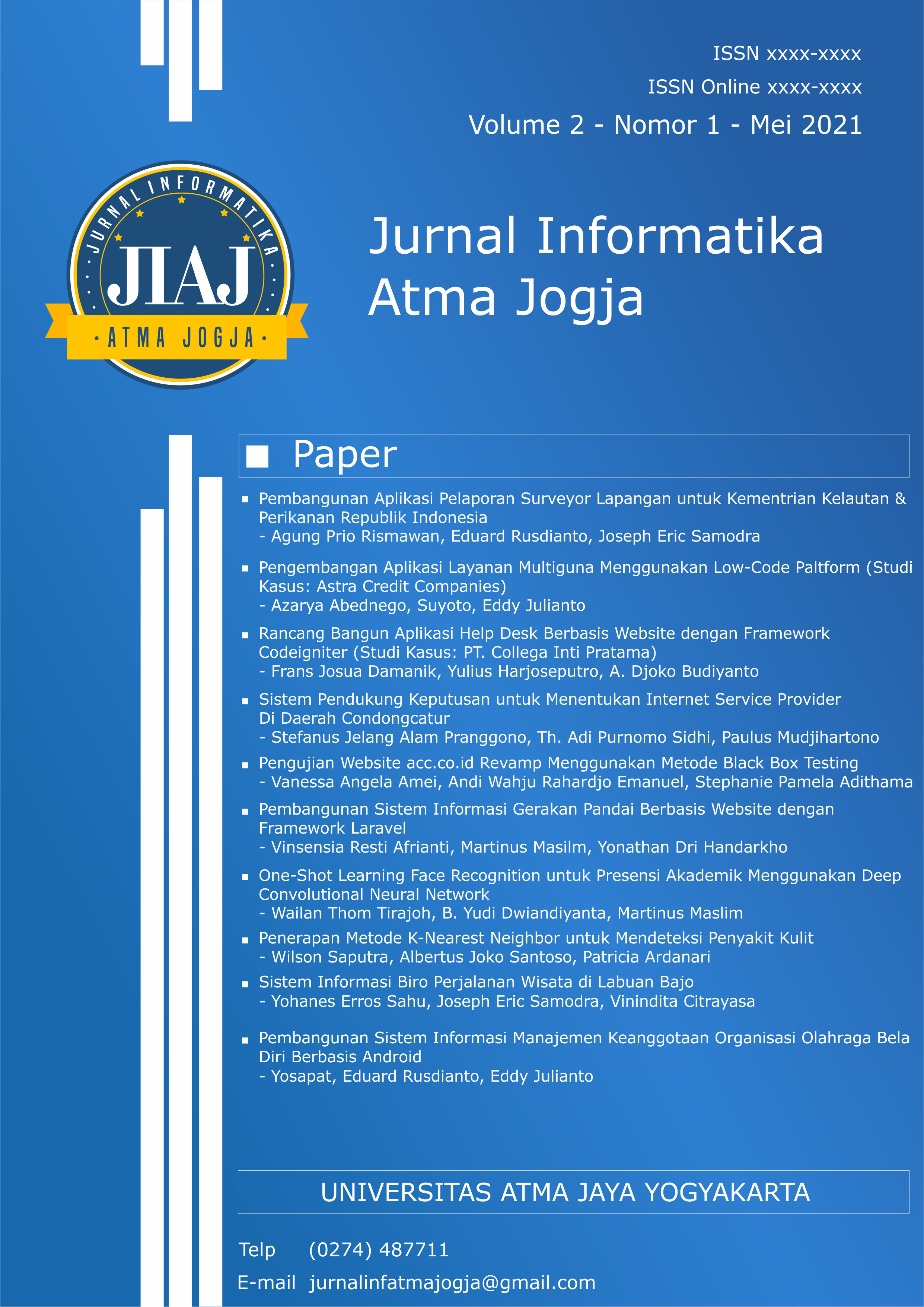One-Shot Learning Face Recognition untuk Presensi Akademik Menggunakan Deep Convolutional Neural Network
Abstract
Untuk pandemi seperti sekarang ini, masyarakat lebih berhati-hati untuk kontak langsung dengan sebuah benda. Sehingga metode presensi dengan menggunakan fingerprint yang mayoritas diterapkan jadi tidak optimal. Agar tidak kontak langsung dengan mesin, pengenalan wajah dapat diterapkan sebagai pengganti proses presensi biometrik. Metode yang digunakan adalah multi-task cascaded convolutional network (MTCNN) untuk deteksi wajah dan Deep Convolutional Neural Network untuk identifikasi wajah. Perancangan aplikasi menggunakan python sebagai bahasa pemrograman, Sqlite3 sebagai basis data, Tkinter sebagai antarmuka, OpenCV & Tensorflow sebagai library pendukung, dan FaceNet & DLib sebagai framework tambahan. Aplikasi
pengenalan wajah untuk presensi dapat meningkatkan proses presensi dengan cepat dan tepat karena model yang digunakan memiliki akurasi yang hampir sempurna (Labeled Faces in the Wild 99.63% & Youtube Faces DB 95.12%) sehingga presensi yang tercatat akurat.
Kata Kunci: Presensi akademik, Deep Convolutional Neural Network, Multi-Task Convolutional Neural Network, Deteksi dan Pengenalan Wajah.
References
W. S. Pambudi, B. Maria, N. Simorangkir, J. T. Elektro, U. I. Batam, and D. Obyek, “Facetracker Menggunakan Metode Haar Like Feature,” vol. 2, no. 2, pp. 142–154, 2012.
P. Viola and Michael Jones, “Rapid Object Detection using a Boosted Cascade of Simple Features,” pp. 1193–1197, 2001.
B. Yang, J. Yan, Z. Lei, and S. Z. Li, “Aggregate channel features for multi-view face detection,” IJCB 2014 - 2014 IEEE/IAPR Int. Jt. Conf. Biometrics, 2014.
M. T. Pham, Y. Gao, V. D. D. Hoang, and T. J. Cham, “Fast polygonal integration and its application in extending haar-like features to improve object detection,” Proc. IEEE Comput. Soc. Conf. Comput. Vis. Pattern Recognit., no. May 2014, pp. 942–949, 2010.
Q. Zhu, S. Avidan, M. C. Yeh, and K. T. Cheng, “Fast human detection using a cascade of histograms of oriented gradients,” Proc. IEEE Comput. Soc. Conf. Comput. Vis. Pattern Recognit., vol. 2, no. May 2014, pp. 1491–1498, 2006.
D. Fleet, T. Pajdla, B. Schiele, and T. Tuytelaars, “Computer Vision - ECCV 2014: 13th European Conference Zurich, Switzerland, September 6-12, 2014 Proceedings, Part IV,” Lect. Notes Comput. Sci. (including Subser. Lect. Notes Artif. Intell. Lect. Note Bioinformatics), vol. 8692, no. November, 2014.
J. Yan, Z. Lei, L. Wen, and S. Z. Li, “The fastest deformable part model for object detection,” Proc. IEEE Comput. Soc. Conf. Comput. Vis. Pattern Recognit., pp. 2497-2504, 2014.
S. Yang, P. Luo, C. C. Loy, and X. Tang, “From facial parts responses to face detection: A deep learning approach,” Proc. IEEE Int. Conf. Comput. Vis., vol. 2015 Inter, no. 3,pp. 3676–3684, 2015.
H. Li, Z. Lin, X. Shen, J. Brandt, and G. Hua, “A Convolutional Neural Network Cascade for Face Detection,” Adv. Exp. Med. Biol., vol. 201, pp. 17–27, 1986.
K. Zhang, Z. Zhang, Z. Li, S. Member, Y. Qiao, and S. Member, “Joint Face Detection and Alignment using Multi-task Cascaded Convolutional Networks Kaipeng,” pp. 1–5.
A. Rahim, N. Hossain, T. Wahid, and S. Azam, “Face Recognition using Local Binary Patterns (LBP),” Glob. J. Comput. Sience Technol. Graph. Vis., vol. 13, no. 4, pp. 469-481, 2013.
Kaya and Bilge, “Deep Metric Learning: A Survey,” Symmetry (Basel)., vol. 11, no. 9, p.1066, 2019.
F. Schroff, D. Kalenichenko, and J. Philbin, “FaceNet: A unified embedding for face recognition and clustering,” Proc. IEEE Comput. Soc. Conf. Comput. Vis. Pattern Recognit., vol. 07-12-June, pp. 815–823, 2015.
P. Purwanto, B. Dirgantoro, and A. N. Jati, “Implementasi Face Identification Dan Face Recognition Pada Kamera Pengawas Sebagai Pendeteksi Bahaya,” eProceedings Eng.,vol. 2, no. 1, pp. 718–724, 2015.
W. J. Nuryanto, “Pengenalan Wajah (Face Recognition) Dengan Menggunakan Metode SURF (Speeded Up Robust Features),” p. 200, 2017.
S. Monika, A. Rakhman, and Lindawati, “Pengaman Rumah dengan Sistem Face Recogntition secara Real Time Menggunakan Metode Principal Component Analysis,” Pros. SNATIF Ke-4 Tahun 2017, pp. 35–40, 2017.
S. Al-Aidid and D. Pamungkas, “Sistem Pengenalan Wajah dengan Algoritma Haar Cascade dan Local Binary Pattern Histogram,” J. Rekayasa Elektr., vol. 14, no. 1, pp. 62-67, 2018.
Downloads
Published
Issue
Section
License

This work is licensed under a Creative Commons Attribution-ShareAlike 4.0 International License.
Copyright of this journal is assigned to Jurnal Informatika Atma Jogja as the journal publisher by the knowledge of author, whilst the moral right of the publication belongs to author. Every printed and electronic publications are open access for educational purposes, research, and library. The editorial board is not responsible for copyright violation to the other than them aims mentioned before. The reproduction of any part of this journal (printed or online) will be allowed only with a written permission from Jurnal Informatika Atma Jogja .






